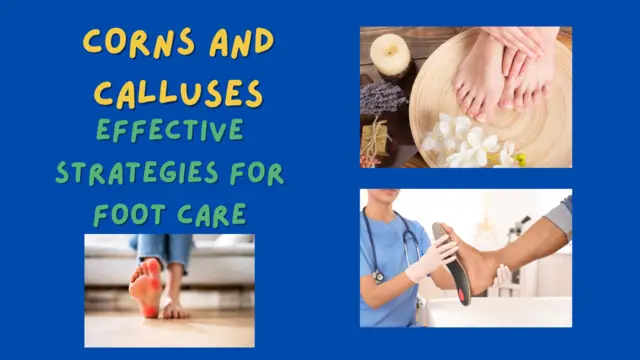Corns and calluses, though often considered minor foot problems, can cause discomfort and pain if unmanaged. These thickened, hardened areas of skin develop due to repeated friction or pressure, typically from ill-fitting shoes or repetitive activities. While treating existing corns and calluses is important, taking proactive steps to prevent their formation is equally crucial. By implementing effective strategies for foot care, you can minimize the likelihood of experiencing these uncomfortable conditions.
Wear Properly Fitted Shoes
One of the primary causes of corns and calluses is wearing shoes that are too tight or too loose. Opt for footwear that allows your toes to wiggle without being too spacious. Additionally, choose shoes made from breathable materials to reduce moisture and friction.
“Ill-fitting shoes are a common culprit behind the development of corns and calluses. Too tight-shoes can exert pressure on specific areas of the foot, leading to friction and thickened skin. On the other hand, shoes that are too loose may cause excessive rubbing and irritation. It’s crucial to choose shoes that provide adequate room for your toes to move freely without constriction. Look for footwear with a wide toe box and sufficient arch support. Additionally, opt for shoes made from breathable materials like leather or mesh to reduce moisture accumulation and friction.”
Use Protective Padding
To shield vulnerable areas of your feet from friction, utilize protective padding such as moleskin or silicone gel cushions. These pads act as a barrier between your skin and the source of pressure, preventing the formation of corns and calluses.
Protective padding serves as a barrier between vulnerable areas of the foot and the source of pressure or friction. Moleskin pads, gel cushions, or silicone toe sleeves can be applied to areas prone to corns and calluses to prevent the formation of thickened skin. These pads absorb shock, reduce friction, and distribute pressure more evenly across the foot, minimizing the risk of developing painful lesions.
Maintain Good Foot Hygiene
Regularly wash and thoroughly dry your feet to prevent the buildup of sweat, bacteria, and dead skin cells that can contribute to corns and calluses. Moisturize your feet with a hydrating lotion to keep the skin soft and supple.
Proper foot hygiene is essential for preventing corns and calluses. Wash your feet daily with mild soap and warm water, paying attention to the spaces between your toes and areas prone to sweating. After washing, thoroughly dry your feet, especially the areas between the toes, as moisture can contribute to skin maceration and increase the risk of corns and calluses. Apply a moisturizing lotion to keep the skin hydrated and prevent dryness and cracking.
Trim Toenails Carefully
Trim your toenails straight across and avoid cutting them too short to prevent ingrown toenails, which can lead to pressure and friction on the surrounding skin, resulting in corns and calluses.
Ingrown toenails occur when the edges of the toenails grow into the surrounding skin, causing pain, and inflammation, and potentially leading to corns and calluses. To prevent ingrown toenails, trim your nails straight across and avoid cutting them too short. Use a nail clipper specifically designed for toenails and avoid rounding the corners, as this can encourage the nails to grow into the skin.
Wear Socks
Choose socks made from moisture-wicking materials to keep your feet dry and reduce friction. Avoid wearing socks with seams that may rub against your skin and cause irritation.
Socks act as a cushioning layer between your feet and your shoes, reducing friction and minimizing the risk of developing corns and calluses. Choose socks made from moisture-wicking materials like cotton or bamboo to keep your feet dry and comfortable. Seamless socks are preferable, as they reduce the likelihood of rubbing and irritation against the skin. Ensure that your socks fit well and do not bunch up or wrinkle inside your shoes.
Cushion High-Pressure Areas
If you have certain areas of your feet that are prone to corns and calluses, such as bunions or hammertoes, consider using orthotic inserts or custom-made shoe inserts to redistribute pressure and alleviate discomfort.
If you have foot deformities such as bunions, hammertoes, or prominent bones, these areas may be more susceptible to corns and calluses due to increased pressure and friction. Orthotic inserts or custom-made shoe inserts can help redistribute pressure, provide cushioning, and correct biomechanical imbalances that contribute to foot problems. These inserts can be placed inside your shoes to provide additional support and relieve pressure on specific areas of the foot, reducing the risk of corns and calluses forming.
Limit Time Spent Barefoot
Walking barefoot increases the risk of developing corns and calluses, especially on hard surfaces. Wear supportive footwear both indoors and outdoors to protect your feet from excessive pressure and friction.
Walking barefoot, especially on hard surfaces like concrete or tile floors, can increase the risk of developing corns and calluses. Without the protection of shoes, the skin of the feet is more susceptible to friction, pressure, and injury. Wear supportive footwear both indoors and outdoors to provide cushioning and protection for your feet. Even within the home, wearing supportive slippers or shoes can help prevent foot problems and promote overall foot health.
Address Foot Deformities
If you have foot deformities such as bunions or hammertoes, consult with a podiatrist to explore treatment options that can alleviate pressure and reduce the risk of corns and calluses developing in these areas.
Certain foot deformities, such as bunions (a bony bump at the base of the big toe) or hammertoes (an abnormal bending of the toe joints), can predispose individuals to corns and calluses due to structural abnormalities and increased pressure on specific areas of the foot. If you have foot deformities that contribute to corns and calluses, consult with a podiatrist or orthopedic specialist for evaluation and treatment options. They may recommend orthotic devices, splints, padding, or surgical interventions to alleviate pressure and correct deformities, reducing the risk of corns and calluses developing.
Monitor Your Feet Regularly
Check your feet regularly for any signs of redness, tenderness, or thickened skin, and address any issues promptly to prevent them from worsening.
Regular self-examination of your feet is crucial for identifying early signs of corns, calluses, blisters, or other foot problems. Check your feet daily for any changes in skin color, texture, or appearance, as well as areas of tenderness or discomfort. Early detection allows for prompt intervention and treatment, preventing minor issues from progressing into more significant problems.
Seek Professional Advice
If you’re uncertain about the best strategies for preventing corns and calluses or if you’re experiencing persistent foot pain or skin lesions, seek professional advice from a podiatrist or foot care specialist. They can perform a comprehensive evaluation of your feet, identify any underlying issues contributing to corns and calluses, and provide personalized recommendations and treatment options tailored to your specific needs. Whether it’s fitting for orthotic devices, recommending footwear modifications, or performing minor procedures to alleviate pressure, a qualified healthcare provider can help you effectively manage and prevent corns and calluses.
By implementing these effective strategies for foot care, you can minimize the risk of developing corns and calluses and maintain healthy, pain-free feet for years to come. Taking proactive steps to prevent foot problems is essential for promoting overall well-being and quality of life.


